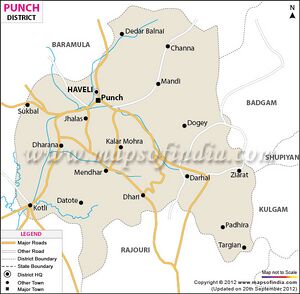Chhajla
| Author:Laxman Burdak, IFS (R) |

Chhajla (छाजला) is a village in tahsil Mendhar of Poonch district in the union territory of Jammu and Kashmir, India.
Variants
Location
Chhajala is a Village in Mendhar Block in Poonch District of Jammu & Kashmir State, India. It is located 18 KM towards South from District head quarters Poonch. 93 KM from State capital Srinagar, Jammu. Chhajala is surrounded by Balakote Block towards East , Surankote Block towards East , Poonch Block towards North , Manjakote Block towards South . Punch , Rajauri , Baramula , Sopore are the near by Cities to Chhajala Lower. This Place is in the border of the Poonch District and Rajauri District. Rajauri District Manjakote is South towards this place . [1]
Jat Gotras
- Chhaj (छाज)
History
Ram Kund Temple
Ram Kund: Ram Kund is the oldest temple in Poonch region. It is located in the village of Chajjla, 6 km from Mendhar. This temple was built by Lalitaditya between 724 and 761.[2] In the temple's courtyard there are three sacred ponds, known as Ramkund, Lakshmankund and Sitakund. A water spring also emerges from Ramkund. Ramkund is 8–19 km from Mendhar bus stand. Pilgrims visit during the month of March in Chaitra chawdish.
Lalitaditya had built Poonch city but at present there is no building existing on ground belonging to Lalitaditya except Ram Kund Temple Mendhar. Mr Stein who translated Rajatarangini, visited Poonch in 1892, identified a number of places like Loharkote (Loran), Attalika (Atoli), Saramber (Chamber Kanari), Savvernik (Surankote) mentioned in Rajatarangini. He could not locate Ram Kund as it was located in very remote area. Other proof is that Devadasis reported to Lalitaditya that they belonged to a nearby village known as Sover Dehmana, which is still existing near Narol, where Ram Kund Temple exists, known as Dharana instead of Dehmana.[3]
Rajatarangini[4] mentions....There was not a town or village, or island, or river, or sea, where Lalitaditya did not raise triumphal monuments. These monuments he named according to the event or the time. When he set out on his expedition, he felt certain of conquest, and built a town named Sunishchitapura (सुनिश्चितपुर), or the " City of Certainty." When in his pride of conquest, he built another named Darpitapura (दर्पितपुर), or the " City of Pride," in which he set up an image of Keshava. And when his conquests were over, and he was enjoying the fruits of his victories, he raised another city ' which he named Phalapura (फलपुर) (phala signifying fruit or effect). He completed Parnotsa (पर्णोत्स) and built a house for amusement named Krirārāma (क्रीराराम), the name indicating the purpose of the building.
Source - https://poonch.nic.in/places-of-interest/

